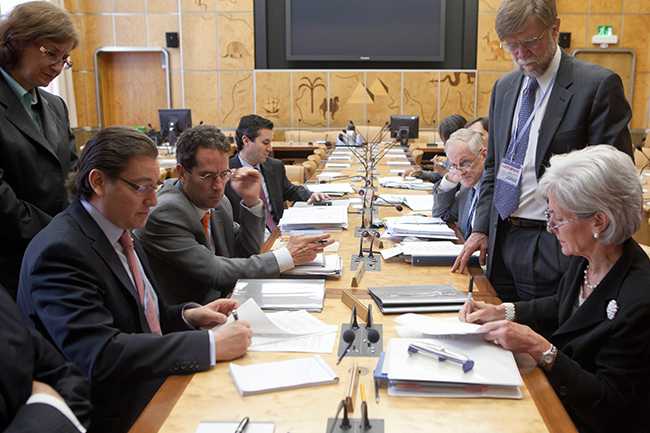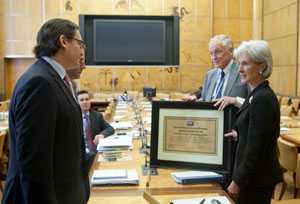United States and Mexico Strengthen U.S.-Mexico Binational Health

Mexico Secretary of Health Salomón Chertorivski and US Health and Human Services (HHS) Secretary Kathleen Sebelius sign a declaration adopting shared guidelies for public health events. Nils Daulaire, Director of the Office of Global Affairs, stands next to Secretary Sebelius. Seated to the right of Dr. Daulaire is CDC’s Center for Global Health Director, Dr. Kevin De Cock.
Health and Human Services (HHS) Secretary Kathleen Sebelius and Mexico Secretary of Health Salomón Chertorivski announced a series of new steps to strengthen health security cooperation between the two countries. The health secretaries outlined these efforts during a meeting coinciding with the 65th World Health Assembly in Geneva, Switzerland, on May 22, 2012. “The United States and Mexico have had a long and close relationship in supporting and improving our ability to respond to public health events and emergencies of mutual interest when they arise,” Secretary Sebelius said. “The trade links between our two countries, our common border, and the high degree of trade in food products speak to the need for close bilateral cooperation in health security for both of our nations.”
The two health secretaries signed a declaration formally adopting a shared set of technical guidelines that both countries will follow to respond to public health events affecting both countries. The Technical Guidelines for United States-Mexico Coordination on Public Health Events of Mutual Concern are accessible from the U.S. Centers for Disease Control and Prevention’s (CDC) Division of Global Migration and Quarantine (DGMQ) in the National Center for Emerging and Zoonotic Infectious Diseases (NCEZID). The guidelines complement the International Health Regulations, which call for neighboring countries to develop accords and work together on shared epidemiologic events and public health issues. The Center for Global Health and DGMQ led the development of the guidelines through close collaboration with counterparts in Mexico, and support from the HHS Office of the Assistant Secretary for Preparedness and Response.

HHS Secretary Sebelius and Dr. Kevin De Cock, CDC’s Director of the Center for Global Health, present Mexico Secretary of Health, Salomón Chertorivski, with a plaque welcoming Mexico as a member of CDC’s Laboratory Response Network.
Secretaries Sebelius and Chertorivksi also signed a renewed agreement between the United States and Mexico that strengthens existing bilateral food safety cooperative activities. This arrangement recommits the two countries to communicate on food safety and to identify areas for coordination and collaboration between several U.S. and Mexican agencies—HHS, through its Food and Drug Administration, and the Department of Agriculture in the U.S.; and the Secretariat of Health and Secretariat of Agriculture, Livestock, Rural Development, Fisheries and Food in Mexico.
Finally, Secretary Sebelius presented Secretary Chertorivksi with a plaque welcoming the Mexican Secretariat of Health’s National Institute of Epidemiological Diagnosis and Reference as a member of CDC’s Laboratory Response Network, which is managed by the Division of Preparedness and Emerging Infections (NCEZID). This achievement is a result of Mexico’s upgraded capabilities to respond quickly to acts of biological terrorism, emerging infectious diseases, and other public health threats and emergencies.
- Page last reviewed: December 23, 2016
- Page last updated: December 23, 2016
- Content source:


 ShareCompartir
ShareCompartir